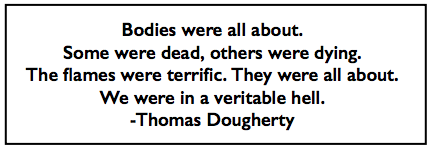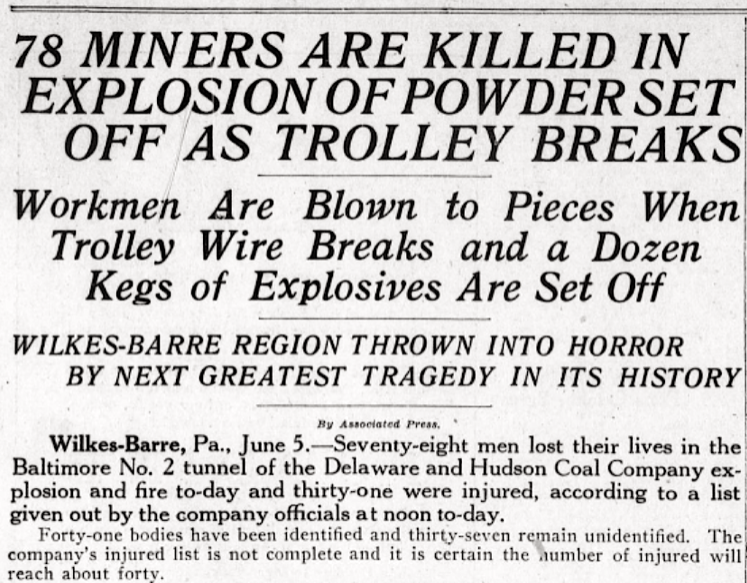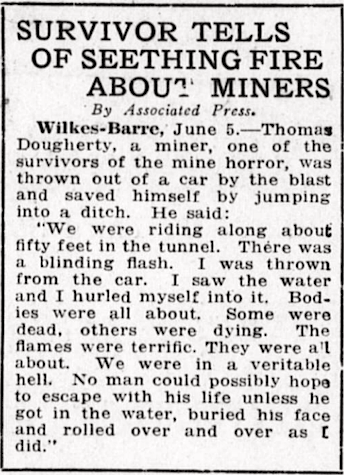 ———-
———-
Hellraisers Journal – Friday June 6, 1919
Wilkes-Barre, Pennsylvania – Coal Miners Perish in Flames of Mine Fire
From Pennsylvania’s Harrisburg Telegraph of June 5, 1919:
—–
Sparks Ignite Powder
More than 100 mine workers were riding to their work crowded into what is known as a “trip” of mine cars, drawn by a motor. The rear car carried twelve kegs of black powder used for blasting loose the coal in the chambers. When the train had gone about 200 feet from the entrance the trolley wire snapped. The sparks it emitted touched off the powder.
There was a roar and in an instant every man and boy on the train was either dead or dying. Mangled bodies were found everywhere by the rescue crews which rushed into the mine. Fire fighters, working frantically, soon succeeded in subduing the flames which followed the blast. Those who had not already succumbed were so badly burned that in nearly every case death was a matter of only a short time.
Carelessness Leads to Horror
Carelessness and violation of mine laws of the State caused the great loss of life. One of the most drastic provisions of the anthracite mine code is the section forbidding the transportation of men on a car or train which carries explosives. Yet the train of little cars conveying its freight of miners had attached to its rear a car of a dozen kegs of powder. Investigation will be made to disclose whether the men or the company is responsible for this violation of the law.
The accident occurred shortly before 7 o’clock. A train of empty cars was sent to the mouth of the tunnel to take the men into the chambers. One hundred men piled into the cars, which was drawn by an electric motor. Near the end of the train was a car of black powder.
When 200 feet in the tunnel, the trolley wire broke and fell. Sparks ignited the powder and instantly there was an explosion that sent the bodies of men flying in all directions.
Many Burned to Crisp
Flames caused the greater loss of life, many of the bodies being burned to a crisp. Other men who were burned and were trying to reach safety died of suffocation.
When rescuers reached the tunnel, dead and dying were scattered everywhere. The injured were rapidly removed and sent to hospitals as quickly as ambulances could be provided, and then dead were brought out and placed in tiers on the green. Hospitals quickly filled and morgues were filled to overflowing.
Company employes state that there is a “pull” of 186,000 cubic feet of air per minute in the tunnel and that the air pulled in the flames from the powder directly over the men. Along the side of the tunnel there is a creek, and at the flash of the flames some men who were walking along the side of the trip of the cars, dropped into the water and saved their lives.
Several employes state that it was not the force of the explosion that killed the men but that flames and lack of air caused all the fatalities. All admit that the accident was the result of a violation of the law, but they state that miners are accustomed to these violations.
Soldiers’ Fathers Victims
East End last night was the scene of great gaiety. That section of the city welcomed home boys from the Three Hundred and Eleventh Field Artillery. Hands were out, flags were [waved?] red fire burned, people laughed and shouted. Within twelve hours all was changed. The fathers of some of the soldiers were among the dead.
Bodies Beyond Recognition
Identification of the bodies is almost impossible. Many of them are charred beyond recognition. The limbs of some, the heads of others, are missing. At 9:30 A. M. it was said between 75 and 100 were killed or had died of injuries.
The death list is rapidly growing. As the bodies were removed from the mine, living and dead, they were piled on the green about the colliery. Many of the injured lived but a short time.
Children Flee in Fright
Hundreds of women, men and children gathered about the tunnel. As they lifted the blankets from the bodies women fainted, men lost their nerve and children ran away in fright. The bodies of scores were removed to the morgues, where the work of identification is being carried on with little success.
The death list was made large by the flames and the sulphur fumes which filled the tunnel. The fire did not last long, but it was long enough to make a heavy death toll. Many of the men were killed outright, parts of bodies being found in the wreckage of life and property.
Rescuers Play on Flames
Rescuers got into the mine with hose and played streams of water on the flames. While they were doing this the cries of the dying and the injured were heard above the roar of the flames.
To-day’s catastrophe is next to the greatest this section of the anthracite coal fields has seen.
Law Is Violated
To-day’s accident is a direct result of violation of the law. Permission was given the men to ride to their place of work and a special train was provided for that purpose. On these cars special seats were built and the train was in daily use.
It is a violation of the mine law to carry powder on a train. The law is specific that powder and other explosives must be transported alone. There were a dozen kegs of powder in one of the rear cars, all of which were exploded.
Mine officials and State officials were on the scene promptly, but their efforts were directed solely to the work of rescue. There were enough men to meet all needs for the work inside the mine, but the chief trouble during the early hours was in getting nurses, doctors and supplies.
———-
[Emphasis added.]
~~~~~~~~~~~~~~~~~~~~~~
SOURCE & IMAGES
Harrisburg, Telegraph
(Harrisburg, Pennsylvania)
-June 5, 1919
https://chroniclingamerica.loc.gov/lccn/sn85038411/1919-06-05/ed-1/seq-1/
See also:
United States Mine Rescue Association
Mine Disasters in the United States
https://usminedisasters.miningquiz.com/saxsewell/Baltimore_tunnel.htm
Delaware and Hudson Coal Company
Baltimore Tunnel No. 2
Explosives Detonation
Wilkes-Barre, Luzerne County, Pennsylvania
June 5, 1919
[Official] No. Killed – 92
From Titusville Herald, Titusville, PA
Note: Article ends with names of dead, known at that time.
https://usminedisasters.miningquiz.com/saxsewell/Baltimore_tunnel.htm#herald
83 Killed and Fifty Burned and Mangled
Titusville Herald, Pennsylvania
By Associated Press
June 6, 1919
USBM Final Investigation Report
Re Explosion at Baltimore Tunnel No. 2 Mine
Wilkes Barre PA, June 5, 1919
https://usminedisasters.miningquiz.com/saxsewell/06-05-1919_Baltimore_Tunnel.pdf
Notes:
Re: “To-day’s catastrophe is next to the greatest this section of the anthracite coal fields has seen.”
In Luzerne County, up to 1919, the only mine disaster with more fatalities was the Avondale Mine Fire of 1869 which claimed the lives of 110 miners.
https://usminedisasters.miningquiz.com/Mine_Disasters/search_all_county.asp?COUNTY=Luzerne+County%2C+PA
The deadliest mine disaster in Pennsylvania was the Darr Mine Disaster of Dec 19, 1907 at Van Meter.
https://usminedisasters.miningquiz.com/Mine_Disasters/search_all_state.asp?ACC_STATE_NAME=Pennsylvania
December 1907 was the deadliest month ever in the history of U. S. coal mining.
Tag: December 1907
https://weneverforget.org/tag/december-1907/
Mine Disasters 1907, see December
https://usminedisasters.miningquiz.com/Mine_Disasters/search_all_year.asp?ACC_YEAR=1907&x=19&y=5
“U.S. Coal Mining’s Deadliest Month: December 1907”
Posted on December 7, 2016 by Trevor Hammond
https://blog.newspapers.com/u-s-coal-minings-deadliest-month-december-1907/
~~~~~~~~~~~~~~~~~~~~~~~~~~~~~~~~~~~~~~~~~~~~~
West Virginia Mine Disaster – Kathy Mattea
Lyrics by Jean Ritchie


